Japanese Beetle (Popillia japonica Newman)
1Department of Biology, USU, 2Utah Department of Agriculture and Food
Quick Facts
• Japanese beetle is an invasive insect that was initially detected in Orem, Utah, in July 2006.
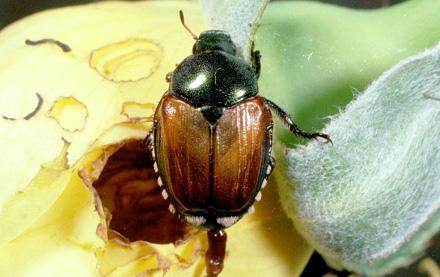
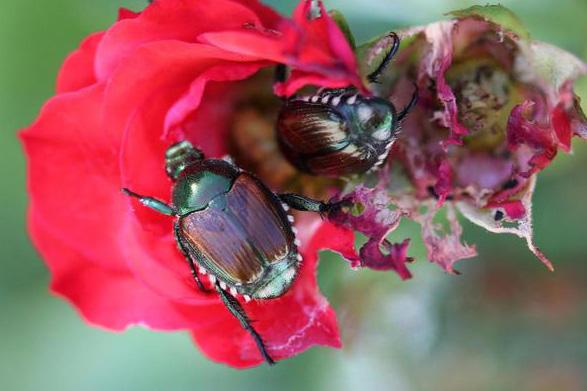
• Past eradication efforts were highly successful. However, constant pressure from travel and trade has resulted in a few additional captures in monitoring traps in recent years.
• Adults have a broad host range (over 300 plant species) and can cause significant damage.

• The immature stage (grubs) prefers to feed on roots of turfgrass and spends about 10 months of the year under the soil surface.
• Homeowners can successfully manage Japanese beetle with proactive cultural practices, biological control, and reduced-risk insecticides.
Japanese beetle (JB) is an invasive pest that can be highly destructive to ornamentals, trees, shrubs, turfgrass, and some fruits and vegetables. JB was likely introduced from Japan into the eastern U.S. in 1916 in shipments of ornamental plants. It is now established in most Eastern and some Midwestern states. In 2006, a small population of adult beetles was detected in Orem, Utah. A subsequent and aggressive eradication program directed by the Utah Department of Agriculture and Food (UDAF) successfully eliminated JB from Utah. Even though constant pressure from travel and trade resulted in eight beetle captures in monitoring traps from 2012-2015, follow-up, high-density trapping resulted in no additional captures. Then in 2018, three more beetles were detected in Salt Lake County. The following year, in 2019, 36 beetles were captured in Salt Lake County and seven in Davis County – the highest in more than a decade. UDAF declared an emergency in 2020 and is now working to eradicate this pest. If you suspect JB in Utah, please contact the Utah Department of Agriculture and Food or USU’s Utah Plant Pest Diagnostic Lab
the body.
DESCRIPTION
Adults are oval, metallic green with bronze-colored wings, and are about ½ inch long. Males are slightly smaller than females. Adults have six white tufts of hair along each side of the body (i.e., five pairs along each side of the abdomen and another pair on the last abdominal segment) and prominent spines on their legs (Figs. 1 and 2). Grubs are creamy white, C-shaped, and 1 inch long when fully grown (Fig. 3). Adults may be found clustered together on plants and grubs can be clumped under the soil of turfgrass.
Figure 2. Adult beetles have six white tufts of hair along each side of
June 2020
Page 1 UPPDL, 5305 Old Main Hill, Logan UT 84322, utahpests.usu.edu
Published by Utah State University Extension and Utah Plant Pest Diagnostic Laboratory
ENT-218-20
Lori Spears1 • Diane Alston1 • Joey Caputo2 • Erin Hodgson1 • Cory Stanley1 • Kristopher Watson2
Figure 1. Adult Japanese beetles feed on more than 300 host species.
DAMAGE SYMPTOMS
JB attacks over 300 plant species, including rose, grape, sweet corn, peony, zinnia, raspberry, sunflower, maple, apple, cherry, peach, birch, hawthorn, and willow (Table 1). Both the adults and grubs (immatures) can cause significant damage when in high numbers. Damage caused by adult beetles appears as skeletonized leaves with veins still intact (Figs. 4 and 5). They also chew holes in flower buds and petals, soft fruits, and corn silks (Fig. 6). Grubs feed on roots belowground, causing discolored patches of turfgrass which, if heavily damaged, can feel spongy and pull easily away from the soil surface (Figs. 7 and 8). Other plants may begin to display yellow and brown foliage. Adults can be found individually or clustered together on plants (Fig. 5), whereas grubs can be clumped under the soil of turfgrass (Fig. 8).
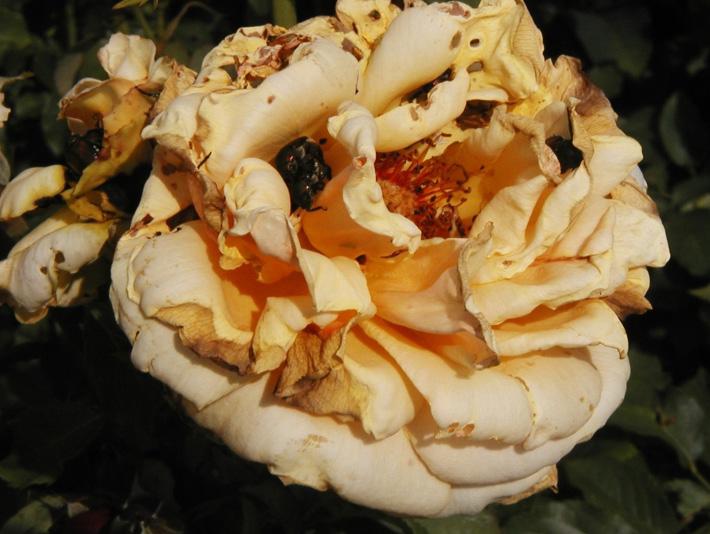



Page 2 UPPDL, 5305 Old Main Hill,
utahpests.usu.edu
Logan UT 84322,
Figure 3. Grubs are C-shaped when at rest.
Herbaceous Plants Woody Plants Primary Secondary Primary Secondary • Common mallow • Dahlia • Evening primrose • Grape • Hibiscus • Hollyhock • Sweet corn • Asparagus • Cardinal flower • Clematis • Gladiolus • Morning glory • Peony • Raspberry • Rhubarb • Sunflower • Zinnia • American mountain ash • Apple, crabapple • Crape-myrtle • Japanese and Norway maple • Linden
• Rose • Sassafras • Stone fruits
• Virginia
• Beech • Black walnut • Birch • Hawthorn • Horse chestnut • Larch • Lombardy poplar • Marshmallow (Althaea) • Summer-sweet (Clethra) • Willow Table 1. Plants with known susceptibility to Japanese beetle.
(American and European)
(apricot, cherry, peach, plum)
creeper
Figure 5. Adults can be found individually or clustered together.
Figure 4. Adult feeding can appear as skeletonized leaves.
Figure 6. Adult feeding damage on rose blooms.
LIFE CYCLE
JB has one generation per year and grubs spend about 10 months under the soil surface (Fig. 9). Adults emerge from turfgrass in late June and immediately begin to feed on low-growing plants such as roses and shrubs. Adults eventually move higher to tree foliage to feed and mate. Mated females move back to turfgrass to lay small egg masses in soil cavities. Females prefer to lay eggs in healthy, vigorous turfgrass and will avoid stressed lawns. Large plantings of turfgrass (e.g., athletic fields, parks) are especially attractive. Most eggs are laid between mid-July and early September. The eggs hatch into small grubs that feed on roots underground until late September when the temperature cools. The near mature grubs burrow 4 - 8 inches into the soil and remain inactive during winter. In the early spring, they begin to feed again and turn into resting pupae. The pupae hatch into adults and emerge from the soil in spring; thus, their life cycle requires a full year to complete.
Figure 9. Japanese beetle has one generation per year and overwinters as a grub (larva) in the soil.
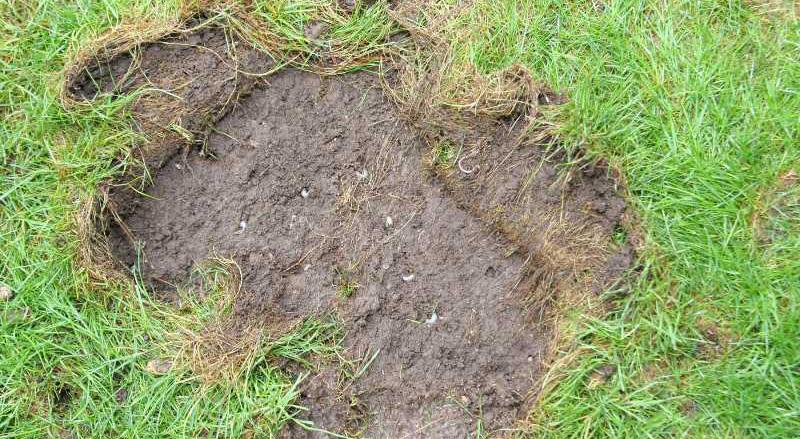

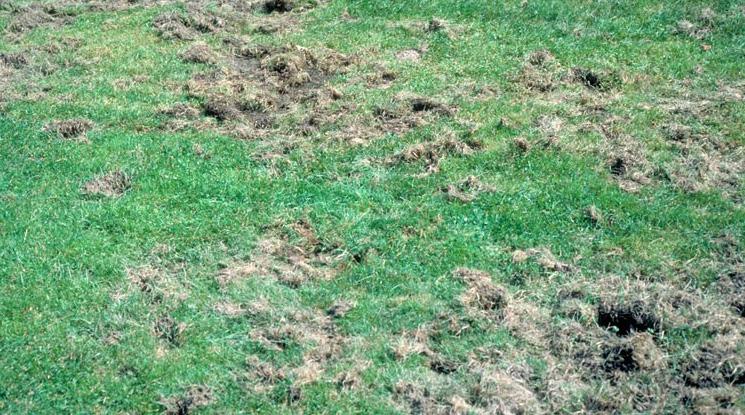
Page 3
UPPDL, 5305 Old Main Hill, Logan UT 84322, utahpests.usu.edu
Figure 8. Turf damaged by grubs can be easily pulled away from the soil surface.
Figure 7. Grub feeding causes patches of discolored turf. Other animals damage turf even further as they search for grubs to eat.
JB can be monitored using traps or visual surveys for adults or grubs. Traps are baited with two chemical lures, a pheromone (sex attractant) and a floral lure, that work together to attract both male and female beetles. Traps are funnel-shaped and either all green in color or bicolor with yellow and green (Fig. 10). The all-green traps are more discreet and capture fewer non-target insects (e.g., pollinators); however, the bicolor trap is more attractive to JB. Traps should be placed in representative locations for monitoring, but at a reasonable distance from high value host plants to avoid plant injury. Traps should be emptied as frequently as possible (1-3 days) to prevent dead beetles from rotting and releasing ammonia, which is known to repel other JBs.
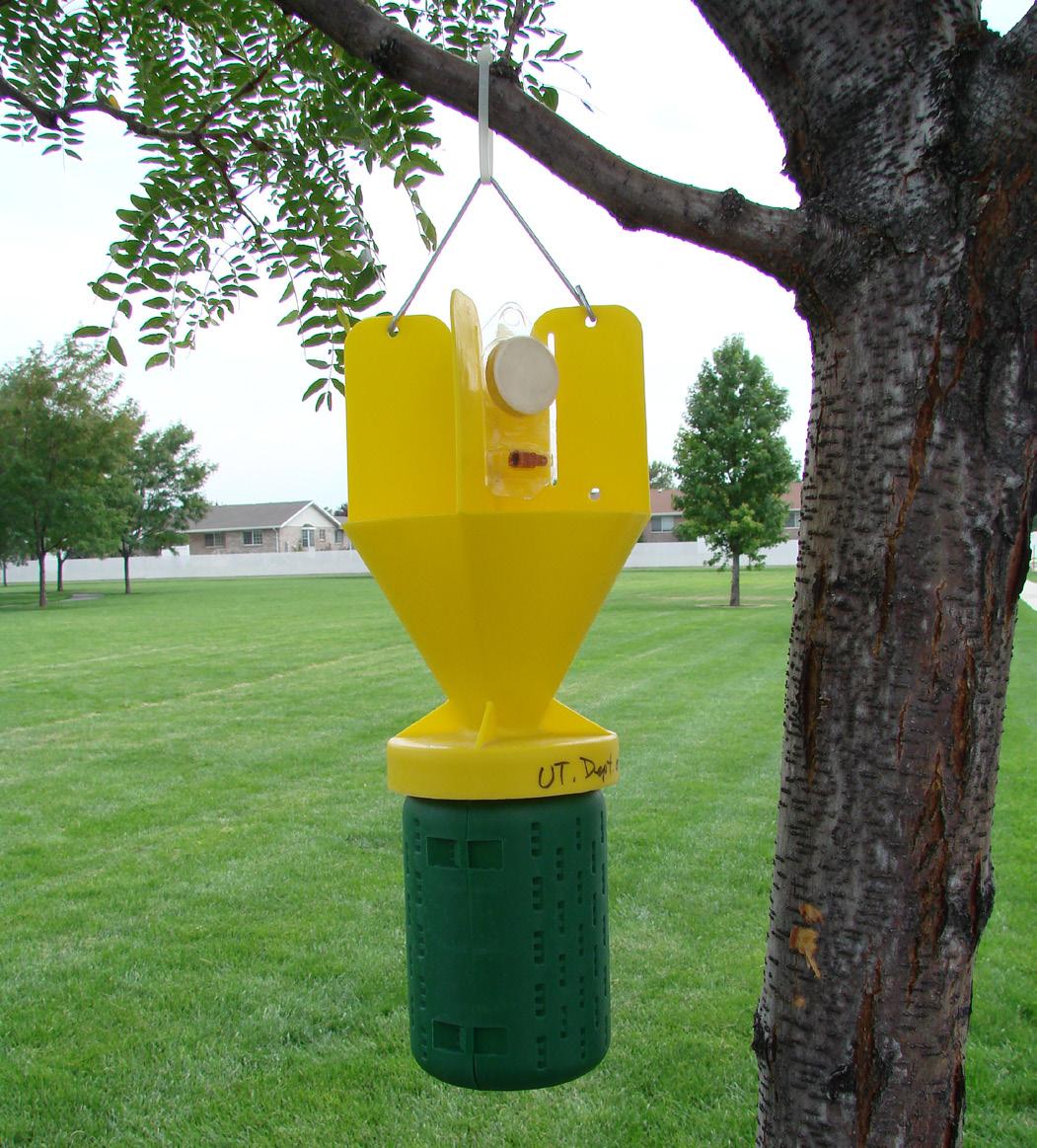
During the summer (mid to late June), look for adults on ornamental plants, trees, and shrubs. Scout susceptible plants at least once per week, especially if adults were active the previous year. Adults are especially attracted to ripening fruits and rosebuds. JB prefer warm, sunny conditions, so visual monitoring should be done during the day and on the sunny side of the plant.
Begin monitoring for grubs in late spring (April to June) and late summer (August to October) by collecting soil and root samples from damaged turf where JB is suspected to occur. Cut a 6 inch square piece of turf with a hand trowel to examine the upper 2 inches of the root zone. Pull apart the roots and soil to look for larvae and feeding injury. After looking through the soil sample, replace the soil and return the turf. Turfgrass that has been fed upon will turn yellow to brown as it dies. Leaves and crowns of grass plants will pull away easily from the roots. Another clue to the presence of grubs in sod is predator digging activity, such as from birds, skunks, badgers, and other grub-eating predators.
MANAGEMENT
Although there have been occasional detections of JB in Utah, the state is currently recognized by the National Plant Board as a “Category 1” noninfested state. This status is granted as a result of the state’s quarantine regulations and annual monitoring efforts. Therefore, Utah residents are advised against taking JB control measures at this time. Instead, JB sightings should be immediately reported to the Utah Department of Agriculture and Food or Utah Plant Pest Diagnostic Lab. However, gardeners, landscapers, and professional growers in JB-infested
areas of the country should take management of this pest seriously to protect valuable host plant material. The following content is for informational purposes.
Control of JB can be difficult, as adults are highly mobile and can easily infest new areas, and adults and grubs often occur on different host plants. The following cultural control strategies can reduce adults and grubs to tolerable levels in most situations.
• Keep plants healthy by following the recommended irrigation and fertilization schedules.
• Include a mix of plants that adult beetles avoid such as lilac, dogwood, and magnolia to discourage adult aggregations (Table 2).
• Use mass-trapping to reduce small and localized populations of JB. Place traps near attractive plants of lower value, such as an old or over-grown rose planting.
• Remove JB by hand for small-scale, localized population reduction. Shake plants or plant parts over a container filled with water to dislodge beetles from plants. Add a few drops of dish soap to the water to allow beetles to sink into the water and drown rather than escape.
• Encourage natural enemies, such as parasitic wasps, flies, ground beetles, and birds, by planting a diversity of flowering plants that produce pollen and nectar.
MONITORING
UPPDL, 5305 Old Main Hill, Logan UT 84322, utahpests.usu.edu Page 4
Figure 10. Mass trapping can be an effective way to reduce Japanese beetle infestations.
Table 2. Plants that are known to be less preferred by Japanese beetle.
Herbaceous Plants Woody Plants
• Ageratum
• Begonia
• California poppy
• Columbine
• Coral-bells
• Coreopsis
• Dusty-miller
• Forget-menot
• Foxglove
• Hosta
• Impatiens
• Lantana
• Larkspur
• Lily-of-thevalley
• Moss rose
• Nasturtium
• Pachysandra
• Pansy, violet
• Poppy
• Showy sedum
• Arborvitae
• Boxwood
• Burning bush
• Dogwood
• Forsythia
• Hemlock
• Hickory
• Holly
• Juniper
• Lilac
• Magnolia
• Northern red oak
• Pine
• Red maple
• Redbud
• Spruce
• Sweetgum
• Tulip poplar
• Yew
REFERENCES & ADDITIONAL READING
Cannon, C., D.G. Alston, D.G., Spears, L.R., Nischwitz, C. & Burfitt, C. (2016). Invasive fruit pest guide for Utah. Utah State University Extension.
Isaacs, R. & Wise, J. (2011). Managing Japanese beetles in fruit crops. Michigan State University Extension.
Krischik, V. & Maser, D. (2005). Japanese beetle management in Minnesota. University of Minnesota Extension.
National Plant Board. (2016). U.S. Domestic Japanese Beetle Harmonization Plan
Potter, M.F., D.A. Potter, D.A., & Townsend, L.H. (2006). Japanese beetles in the urban landscape. University of Kentucky.
Insecticide applications can be an effective management strategy when JB populations have exceeded economic or aesthetic injury thresholds, but should only be used when necessary. Application of foliar insecticides to trees, shrubs and other ornamentals is not recommended because insecticides are expensive and generally ineffective in landscape situations. However, insecticides may help to protect commercial crops, gardens, nursery stock, and high value landscape plantings. Insecticides known to be effective for JB control include:
• carbaryl (1A Carbamates)
• chlorpyrifos, trichlorfon (1B Organophosphates)
• beta-cyfluthrin, bifenthrin, deltametrin, lamdacyhalothrin (3A Pyrethroids/Pyrethrins)
• clothianidin, dinotefuran, imidacloprid, thiamethoxam (4A Neonicotinoids)
• chlorantraniliprole, cyantraniliprole (28 Diamides)
• azadirachtin
See USU Extension’s Invasive Fruit Pest Guide for Utah for more information about effective insecticides. Some insecticides may target a specific life stage and may only be used on specific crops. Be sure to read the label and use only as directed. Note that lawn treatments for grubs would also target JB.
United States Department of Agriculture. (2015). Managing the Japanese beetle: A homeowner’s handbook. USDA, APHIS 81-25-003.
Image Credits
Figure 1. Whitney Cranshaw, Bugwood.org
Figure 2. Clemson University - USDA Cooperative Extension Slide Series, Bugwood.org
Figure 3. David Cappaert, Bugwood.org
Figure 4. Steven Katovich, USDA Forest Service, Bugwood.org
Figure 5. Daniel Herms, The Ohio State University, Bugwood.org
Figure 6. Dow Gardens, Dow Gardens, Bugwood.org
Figure 7. M.G. Klein, USDA Agricultural Research Service, Bugwood.org
Figure 8. Missouri Botanical Garden, missouribotanicalgarden.org
Figure 9. Life cycle by Cami Cannon, Utah State University; adapted from drawings by J. Kalisch (University of Nebraska) and Joel Floyd (APHIS)
Figure 10. Diane Alston, Utah State University
Precautionary Statement: Utah State University Extension and its employees are not responsible for the use, misuse, or damage caused by application or misapplication of products or information mentioned in this document. All pesticides are labeled with ingredients, instructions, and risks. The pesticide applicator is legally responsible for proper use. USU makes no endorsement of the products listed herein.
In its programs and activities, Utah State University does not discriminate based on race, color, religion, sex, national origin, age, genetic information, sexual orientation or gender identity/ expression, disability, status as a protected veteran, or any other status protected by University policy or local, state, or federal law. The following individuals have been designated to handle inquiries regarding non-discrimination policies: Executive Director of the Office of Equity, Alison Adams-Perlac, alison.adams-perlac@usu.edu, Title IX Coordinator, Hilary Renshaw, hilary.renshaw@usu.edu, Old Main Rm. 161, 435-797-1266. For further information on notice of non-discrimination: U.S. Department of Education, Office for Civil Rights, 303-844-5695, OCR.Denver@ed.gov. Issued in furtherance of Cooperative Extension work, acts of May 8 and June 30, 1914, in cooperation with the U.S. Department of Agriculture, Kenneth L. White, Vice President for Extension and Agriculture, Utah State University.
UPPDL, 5305 Old Main Hill,
utahpests.usu.edu Page 5
Logan UT 84322,











